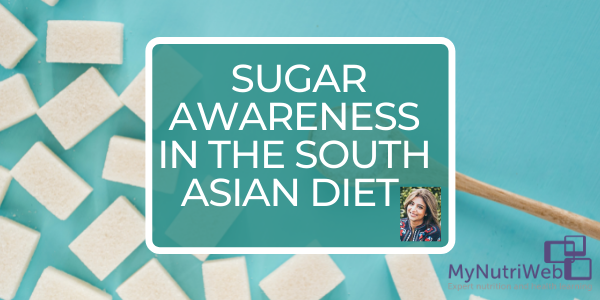Sugar Awareness in the South Asian Diet
Guest author: Fareeha Jay – UK Registered Dietitian who is extremely passionate about providing the best available nutrition advice to people with a Southern Asian background . Today marks the start of Sugar Awareness Week 2021 – a week to raise awareness of the damaging effects of too much sugar within the diet. It’s important that we also recognise the role of sugar within the diets of different ethnic groups, respecting and understanding their dietary choices.
. Today marks the start of Sugar Awareness Week 2021 – a week to raise awareness of the damaging effects of too much sugar within the diet. It’s important that we also recognise the role of sugar within the diets of different ethnic groups, respecting and understanding their dietary choices.
We’ve invited Fareeha to tell us about the importance of sugar awareness within the South Asian Diet. She also kindly shares a lower sugar sooji halwa recipe – a traditional South Asian dessert that’s normally high in sugar.
The role of traditional foods
In the South Asian culture, traditional foods play an important role in the lives of people. Food preparation and eating is interwoven with a myriad of norms, traditions, and customs. One of the most important activity of the day is eating together. Sugar is the hallmark of both sweet and savoury South Asian dishes. However, are South Asian communities having too much sugar? Can healthier swaps be made?

Reducing sugar intake
Sugar is found in varied foods. Starchy carbohydrates such as bread, rice, roti, idli, dosa , poha , pasta, potatoes and cereals have sugar in the form of glucose, while fruit, vegetables and dairy have it in the form of fructose or lactose. Our body needs sugar, and it is the preferred fuel source for all the cells in our body. The body converts it into energy; our brain’s primary source of energy is glucose [1].
When we talk about the importance of reducing sugar intakes, we are referring specifically to ‘free sugars’. Free sugars include all sugars added to food and drinks. It also includes honey, syrups and any sugar present in fruit and vegetable juices, smoothies, purées and pastes. This is because for such sugars the structure of the cells has been broken down [2].The sugars naturally present in milk, dairy products, fruit, vegetables and cereal grains do not count in free sugars [3].
According to the National Diet and Nutrition Survey (2016/2017 to 2018/2019) free sugars intake exceeded the government recommendation, which is no more than 5% of total energy intake [4]. Increased sugar intake is associated with a higher risk of obesity, diabetes, [5] cardiovascular disease [6], non-alcoholic fatty liver disease (NAFLD) [7] as well as cognitive decline [8]. There is also a positive association between increased sugar consumption and dental decay [9].
How much sugar should we be consuming?
There are no guidelines for children under the age of 4 but it’s recommended to avoid sugary food and drinks [10].
The NHS Guidance for other ages are:
- 19 g for children aged 4-6
- 24 g for children aged 7-10
- 30g for adults
To put it into perspective:
- One teaspoon is 6 g
- One Mars bar or 2 gulab jamun will have 30.5 g of sugar (equivalent to 5 teaspoons)
Therefore, by regularly including snacks such as 2 gulab jamun, it can be easy to exceed maximum recommends for free sugars. To go into more detail about other sources of free sugars within the South Asian diet, I’ve outlined the main sources below.
Top sources of sugar in the South Asian diet
Inclusion of some popular traditional foods and drinks in the South Asian diet makes it extremely high in sugar. They are the following:
Mithai
Mithai is not eaten day to day, though it is an integral part of celebrations and festivals. Not only is it eaten on Eid, Diwali, Holi and Raksha Bandhan but also at weddings, birthdays, baby births or passing exams. Traditionally, on these events, boxes of mithai are distributed among family and friends. Mithai is a broad category with hundreds of types, the most popular ones being laddu, barfi, gulab jamun, jalebi and besan.
- One laddu contains approximately 15g of sugar
- One piece of barfi contains approx 20g of sugar
- One jalebi contains approx 20-25 g of sugar
Desserts
Dessert is a part of daily culture for many South Asians families. A part of this dessert culture is to add decadent desserts after all meals. A meal is not considered complete without it. There are no fixed dessert recipes and sugar is added according to the taste and likes of the family.
To get an idea of the amount of sugar that is added to South Asian desserts, is best to compare rice pudding with kheer. Both have rice, milk and sugar but rice pudding has half the sugar of kheer. Apart from kheer, other popular desserts are halwa, zarda, ras-malai, shahi-tukda, kulfi (see table 1).
Drinks
Alongside the traditional drinks, there is a growing culture of soft drink consumption with meals. South Asians are already at a higher risk of diabetes [11] and heart disease [12]; consumption of energy contributing drinks [13] can put them at an even greater risk. Some traditional high sugar drinks are:
One glass of:
- Meethi Lassi = around 12–18g of sugar)
- Shikanjabeen = around 18g of sugar
- Doodh Pati/chai = usually made collectively for the family and difficult to calculate the amount of sugar. In dood pati/chai, sugar can range from 6–24 g a serving
- Rabri Doodh = around 24g of sugar
- Falooda = around 24–30g of sugar
- Doodh Soda = around 20g of sugar
Savoury
Surprisingly, many South Asian savoury dishes are also quite high in sugar because of the added chutneys made from sugar, jaggery, tamarind or plums. Some traditional meals include:
One serving of:
- Chana chaat = around 6–8 g of sugar approximately
- Dahi Bhalla/ Dahi Vada: (8 g of sugar approximately).
- Gole Gappay/Pani Puri: (8 -16 g of sugar approximately).
Table 1
| Mithai | |
| Gulab Jamun | Fried dough balls soaked in a syrup |
| Laddu | Made from flour, sugar, ghee, and nuts |
| Barfi | Milk based mixed with sugar, ghee, and nuts |
| Jalebi | Spiralled mithai made from flour, ghee sugar and orange food colouring |
| Desserts | |
| Halwa | There are different types of halwas. Main ingredient can be semolina, flour, carrots, apple added with sugar and ghee |
| Zarda | Rice with sugar, ghee, dried fruit, nuts, and orange colouring |
| Ras-Malai | Condensed milk balls with sugar, milk, cardamom, and nuts |
| Shahi -Tukda | Bread, milk, sugar, ghee |
| Kulfi | Condensed milk, sugar, and pistachios |
| Drinks | |
| Meethi Lassi | Blended yogurt with sugar. Adding mango is also very popular |
| Shikanjabeen | Lemon drink with sugar |
| Doodh Pati/Chai | Milky tea with sugar |
| Rabri Doodh | Milk, sugar, vermicelli, butter, and dried fruits |
| Falooda | Milk, Rose syrup, sugar vermicelli. |
| Doodh Soda | Milk is mixed with a carbonated drink, usually sprite. |
| Savoury | |
| Chana Chaat | Chickpeas with vegetables, spices, and chutney. |
| Dahi Bhalla/ Dahi Vada | Lentil dumplings with yogurt, spices, and chutney. |
| Gole Gappay/Pani Puri | Fried flour dumplings with chickpeas and chutney usually made from tamarind, sugar and jaggery. |

Top tips for reducing sugar intake
- Reduce the amount of sugar in your drinks or cut back on drinks with high sugar content.
- Rather than having desserts every day, limit intake to every few days
- Opt for fruit-based desserts such as Fruit Chat and Lab e Shireen
- Swap some of the sugar in your desserts and chutneys with soft dates
Summary and recipe
South Asian foods, desserts and drinks can be extremely high in sugar. Adding the foods mentioned, to your diet on a daily basis would mean people going way over the recommended, 30 g of sugar a day .To reduce sugar intake to less than 5 % of the total energy intake , the focus should be on sugar awareness in South Asian foods and promotion of healthier food swaps and recipes .
Sooji halwa (Semolina halwa)
Traditionally this halwa is extremely high in fat and sugar. The amount of sugar added to the halwa is equivalent to the quantity of semolina. In this recipe I have only used a teaspoon of sugar and have swapped most of the sugar with dates and raisins.
Ingredients
- 2.5 dessert spoons semolina
- 2 teaspoon oil
- 1 egg
- 75 ml milk
- 3 dates
- ½ teaspoon cardamom powder
- 1 teaspoon vanilla essence
- Food colouring
- 1 cup water
- 1 teaspoon sugar
- 1 dessert spoon raisins
- 1 teaspoon nuts
- 1 teaspoon desiccated coconut
Method:
- Roast the semolina in pan with oil until fragrant.
- Blend dates, milk and egg and add it to the pan. Cook few minutes.
- Add cardamom powder, vanilla essence, and orange food colouring.
- In a separate pan add sugar and water. Stir and let it heat up on a medium heat.
- Add the liquid to the semolina mixture whisking continuously with one hand.
- Keep stirring until it thickens.
- Add nuts, raisins, and desiccated coconut.
Serve warm. Enjoy!
Related MyNutriWeb content
The South Asian Eatwell Guide (2021)- Blog post by Fareeha Jay RD all about the new adapted Eatwell Guide she has developed, including PDF download of the guide
Taking Action on Sugar: Children’s Snacks (2021) – 60 min webinar with Action on Sugar focusing on how to target sugar in snacks
Action on Sugar: Individual vs Industry Responsibility (2020) – Blog post about reducing sugar consumption in the UK
References:
[1] Slavin,J.,& Carlson,J. (2014) Carbohydrates, Advances in Nutrition , 2014,5 (6):760-761.
[2] Swan,G.,Powell.,Knowles.,Bush,M.,& Levy,L. (2018) A definition of free sugars for the UK.28th March 2018, Cambridge University Press.
[3] NHS. (2020) Sugar: the facts. Eat well.
[4] Public Health England. (2016-2019). National Diet and Nutrition Survey. Rolling programme Years 9-11 (2016/2017 to 2018/2019).
[5] Evans, C. (2016). Sugar and health: a review of current evidence and future policy .05 December 2016,Cambridge University Press.
[6] Howard, B., & Wylie-Rosett,J.(2002) Sugar and Cardiovascular Disease. Circulation, 2002, 106:523-527.
[7] Basaranoglu,M., Basaranoglu,G.,& Busianesi,E.(2015) Carbohydrate intake and nonalcoholic fatty liver disease. Hepatobiliary Surgery and Nutrition 2015 , 4 (2): 109-116.
[8] Lakhan,S.,& Kirchgessner,A.(2013) The emerging role of dietary fructose in obesity and cognitive decline . Nutrition Journal 12:114.
[9] Moynihan,P., & Miller,C. (2020) Public Health and Governmental measures to tackle sugar . Journal of Dental Research.
[10] NHS. (2020) Sugar: the facts. Eat Well.
[11] Diabetes UK. Risk of Type 2 Diabetes in the South Asian community.
[12] Hanif, W., & Susaria, R. (2018) Diabetes and cardiovascular risk in UK South Asians: an overview. Br J Cardiol 2018; 25) suppl 2): S8 -S13.
[13] Vartanian,L ., Schwartz,M ., & Brownell,K.(2007) Effects of soft drinks consumption on nutrition and health : A systematic review and meta-analysis . American Public Health Association 2007 ; 97 940: 667-675.






